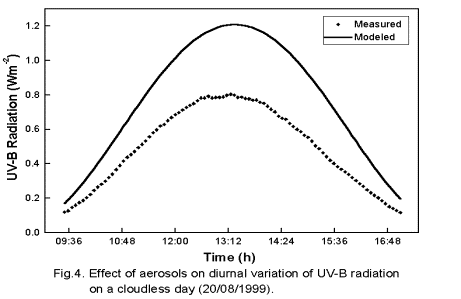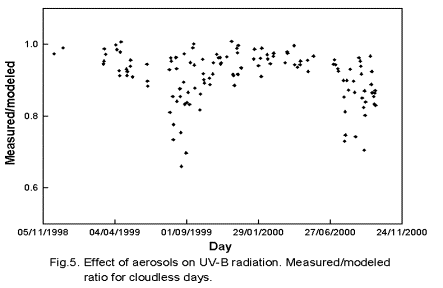
Departamento de Físico Química / INFIQC - Fac. de Cs. Químicas, Universidad Nacional de Córdoba - Ciudad Universitaria, 5000 Córdoba. ARGENTINA
FIGURES
Abstract
Ultraviolet-B radiation (UV-B, 280-315 nm) is monitored in Córdoba, Argentina (31o24' S, 64o11' W, 400 meters above sea level) using the Yankee Environmental Systems (YES) pyranometer, model UVB-1. Measurements of solar broad band UV-B irradiances were conducted between November 1998 and December 1999. These are, to our knowledge, the first measurements obtained in Córdoba with a high quality pyranometer. The site selected for the measurements represents semi-urban conditions and is along the most frequent wind direction (NE-SW). For clear sky days, the measurements are in good agreement with results of a radiative transfer model. However, this study shows substantial reduction of UV-B radiation on days with high levels of air pollution. The maximum UV irradiance measured was 2.61 Wm-2. In this work we investigate the seasonal variation of UV-B radiation to assess its response to air pollution, physical variables, and meteorological factors.
Introduction
The discovery of the Antarctic ozone depletion in 1985 has raised serious questions about the continued protection of the earth living system. Reductions in stratospheric ozone (O3) allow more solar ultraviolet-B radiation (UV-B, 280-315 nm) to reach the earth's lower atmosphere and surface because the stratospheric ozone column is its primary attenuator [1]. UV radiation affects many chemical and biological processes and its increase is of concern because of potential adverse effects on the biosphere and on quality and composition of tropospheric air [2].
The anticorrelation between the total ozone column and UV-B radiation is well established. However, several other atmospheric parameters such as clouds, haze, aerosols, albedo and absorbing gases largely influence the amount of UV-B radiation reaching the ground level due to scattering and absorption. Besides, the seasonal variation of the geometrical path length of solar radiation through the atmosphere plays a dominant role. It is also essential that the measurement instruments be well characterized and that a good calibration of instrumental response be maintained for a long period of time. Because of the combined effect of these parameters in controlling the UV-B levels, attempts to establish a long-term trend in UV-B radiation from existing data records have been until now very difficult, inconclusive or even controversial [3].
The objective of our research is to shed light on the influence of aerosols, clouds and the tropospheric pollutants on the UV-B radiation levels reaching the earth surface.
Measurements and UV-B modeling
Ultraviolet-B radiation is monitored in Córdoba, Argentina (31o24' S, 64o11' W, 400 meters above sea level) using the Yankee Environmental Systems (YES) pyranometers model UVB-1. These are, to our knowledge, the first measurements obtained in Córdoba with high quality pyranometers. The UVB-1 is a precision radiometer that measures global solar UV-B radiation. Global radiation includes both light transmitted directly through the atmosphere and light scattered by atmospheric gases and particulate matter into the atmosphere. The instrument uses colored glass filters and a fluorescent phosphor to convert incoming UV-B radiation into green light, which is then precisely measured by a calibrated solid stated detector. The spectral response of the instrument is similar to the erythemal and DNA damage spectra, making it useful for biological impact studies such as erythemal dose rate studies.
Measurements of solar broad band UV-B irradiances are being carried out since November 1998. The site selected for the measurements represents semi-urban conditions and is along the most frequent wind direction (NE-SW) with reference to downtown. The equipments are mounted on a wide open area in the University Campus. We are also measuring and calculating Erythemally Effective Radiation (EER) which describes the effect of UV-B radiation on the skin (skin-reddening). To convert the UVB-1 instrument output voltage into either effective irradiance or CIE-defined erythemal irradiance in effective Wm-2 the signal voltage must be multiplied by a conversion factor, provided by the manufacturer, for the solar zenith angle at the time the sample was taken.
As complement of the present study, simultaneous observations of total solar radiation (300-3000 nm) are taken using a YES Total Solar Pyranometer model TSP 700. Also, diffuse UV-B radiation is estimated using another UVB-1 pyranometer with a homemade device which consists in a shadow band approximately 15 cm above the detector to shadow it. The National Observatory of Córdoba provides the additional meteorological data.
Radiative transfer models are an important complement to measurements. Models are also an essential aid to identify the causes of observed UV changes, to carry out sensitivity studies, and ultimately to predict future UV environments under different atmospheric O3 reduction scenarios. The global UV-B measurements obtained in this work were compared with radiative transfer model calculations. For our model calculations we used the Sasha Madronich radiative transfer code (1995). This model calculates the direct UV-B irradiance, ultraviolet induced erythema and the photolysis rate constants for several species. The input parameters for the radiative transfer code are date and time, latitude and longitude, surface elevation, total column ozone amount and surface albedo. For our calculations, default temperature, ozone and aerosol profiles were used due to the lack of these data in Cordoba City. All the calculations were carried out under clear sky conditions. The surface reflectivity was assumed to be 5% for the spectral region concerned and for the environment of the measuring site.
Results and discussion
In fig. 1, the daily total column ozone content between 1991 and 2000 over Córdoba city is shown as measured by TOMS (Total Ozone Mapping Spectrometer). The straight line is the best-fit linear trend. The mean value for the last 10 years is 282 Dobson Units (DU). The minimum values are usually recorded between April and May and the maximum ones between August and October.

Figure 2 shows the diurnal variation of the solar UV-B irradiance as measured by the UVB-1 broadband radiometer operating at the campus of the University for a day with no clouds, no aerosol and no pollution. The rain of the previous night ensured these conditions. The model calculation results can also be seen as well as a very good agreement with the experimental measurements.

The annual course of UV-B in Córdoba for 1999 and 2000 is shown in fig. 3, where we plot UV-B irradiance at solar noon for all the days that we could carry out the measurements. Full diamonds represent a radiative model solution assuming clear skies, no aerosols, no clouds and TOMS values from 1999 until present. The empty diamonds represent the experimental measurements which were carried out under diverse meteorological conditions. It can be observed that different levels of air pollution, aerosol and/or clouds result in a significant reduction of the solar irradiance reaching the ground.

The effect of aerosols on UV-B radiation for a cloudless day (20/08/1999) is shown in fig. 4. In this case, the reduction of UV-B radiation, compared with model calculations, ranges from 30 up to 40% depending on the solar zenith angle. This is a usual situation in Córdoba during wintertime when rain is nearly absent and consequently there is not removal of aerosols by wet precipitation [4]. Because of this the aerosol loading increases until wet precipitation clears up the atmosphere. This effect can be seen in fig. 5 which shows the measured/modeled ratio for cloudless days from November 1998 until present.


Unfortunately, aerosols in Córdoba city have not been characterized yet, making it very difficult to draw more than qualitative conclusions. However, preliminary analysis of direct and diffuse UV-B radiation of five consecutive days with high aerosol load demonstrated that in these days there was an important decrease in the direct radiation without an increase in the diffuse one. One possible explanation would be that the aerosols present in wintertime are more efficient in absorbing than scattering UV-B radiation.
The effect of clouds on UV-B radiation can be as varied as the clouds themselves because it depends on many factors such as cloud type, thickness, droplet number density, zenith angle, etc. In addition, cloud condition usually changes considerably in a short time making it very difficult to analyze and predict its effects. Thus and in order to capture the rapid variation in the irradiance, a frequent sampling is necessary. For this reason, readings are taken every 2 seconds and averaged and stored over 30-sec intervals. Figure 6 shows the cloud effects on either UV-B and total radiation.

In this figure different effects can be seen. One of them is the decrease of intensity and the other one is the increase of intensity with reference to cloudless conditions. The decrease is the most common one and it can be as large as 70 % for days heavily cloudy. The increase, called broken cloud effect, is produced on partially cloudy days when the direct sunlight is present and the diffuse one is increased by scattering on the sides of white clouds.
Conclusions
Because ozone strongly absorbs energy in the UV-B, its depletion causes an important increase of the harmful UV-B radiation reaching the ground. Specific concerns include increases in the incidence of skin cancer and ocular damage. Also, clouds, aerosols and pollution affect the radiation levels. The UV-B radiation can be reduced up to 40% for days with high aerosol load and up to 70% for densely cloudy days.
As long-term prediction of UV-B levels is very difficult and uncertain, we thing that two years is not enough time to get more than qualitative conclusions.
In the near future we will measure UV-B radiation in the site described and in downtown simultaneously in order to assess and compare how UV-B radiation is affected in different environments.
Acknowledgments
We thank Fundación Antorchas, TWAS, CONICOR, SeCyT (UNC), and CONICET, for partial support of this work. Gustavo G. Palancar thanks CONICET for a graduate fellowship. We are also grateful to Dr. S. Madronich for providing the computer program for the radiative transfer model.
References
[1] Teramura A. H. and Sullivan J. H., Photobiology, ed E. Riklis, 625-634. New York: Plenum Press, 1991.
[2] Madronich S., McKenzie R., Caldwell M., Björn L. and Tang X., Stratospheric Ozone and Human Health Project, 1994.
[3] Kerr J. B. and McElroy C. T., Science, Vol. 262, 1032-1034, 1993.
[4] Olcese, L. E. and B. M. Toselli, Meteorol. Atmos. Phys., Vol. 62, 241-248, 1997.
Back to
| Session 1 : Stratospheric Processes and their Role in Climate | Session 2 : Stratospheric Indicators of Climate Change |
| Session 3 : Modelling and Diagnosis of Stratospheric Effects on Climate | Session 4 : UV Observations and Modelling |
| AuthorData | |
| Home Page | |